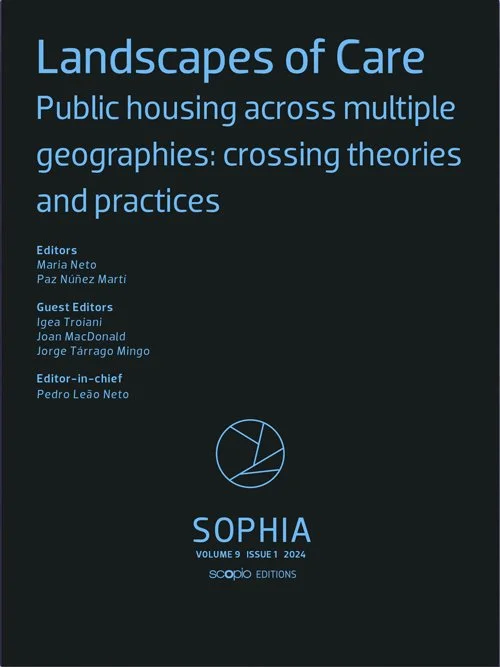Sophia, Volume 9, No. 1 Landscapes of care: Public housing across multiple geographies: crossing theories and practices
Sophia, Volume 9, No. 1 Landscapes of care: Public housing across multiple geographies: crossing theories and practices
Sophia’s third cycle main theme is “Landscapes of Care” with an overall interest around contemporary photography on how architecture can help a broken planet. It intends to understand how the photographic/imagery universe can be explored as a meaningful instrument of research about the multifaceted complex socioeconomic, political, historical, technical and ecological dimensions of architecture, city and territory that testify, question or emerge from relationships of care.
The concept “landscapes of care” has increasingly been adopted by diverse areas of study coming from health geography to the arts and architecture. Taking this notion to the universe of architecture we would like to understand architecture, city and territory as living and inclusive organisms, constituted by multifaceted landscapes with complex social and organisational spatialities which embody the difference and the other, the strange, the unfamiliar, the indigenous, the human and the non-human.
Sophia, Volume 9, No. 1 Landscapes of care: Public housing across multiple geographies: crossing theories and practices, focusing on public housing, allows contributions to be centred on a dynamic reading of the city that is conditional and conditioned by housing typology. Combining architecture, public housing, habitat, and urban planning, we are convoking works that explore an interpretative narrative about housing and those who live in it, pilot projects with communities of practice capable of generating strategic visions about the possible future of city and territory, housing and the lives it (trans)forms, in this ontological relationship between the Man and house.
Public housing should be an example of innovative practices, whether in design or urban and territorial development. However, most interventions carried out through housing policies or specific and isolated actions on public housing need to be sufficiently known and disseminated by authorities, technicians, and researchers to produce broad knowledge and debate. Our objective is to make known and amplify these practices that intertwine theory and action and explore how photography, surveys, testimonies, and documentaries can be used as significant research instruments in the socio-economic, political, historical, technical, and ecological dimensions of social housing, the city and the territory, revealing good practices and models to study. Launching a critical look at city-making from its dominant program - housing - we also intend to establish relationships of continuity and/or rupture, alignments, and/or gaps between housing and urban, socio-political, and architectural thought nationally and internationally.
SSN 2183-8976 [Print] 2183-9468 [Online]
ISBN 978-989-53640-5-3
Volume 9, Issue 1 | Publication year: 2024
DOIs: 10.24840/2183-8976_2024_0009_0001
© The Authors. Published by scopio Editions. Licensed under a Creative Commons Attribution-NonCommercial-NoDerivatives 4.0 International License.














